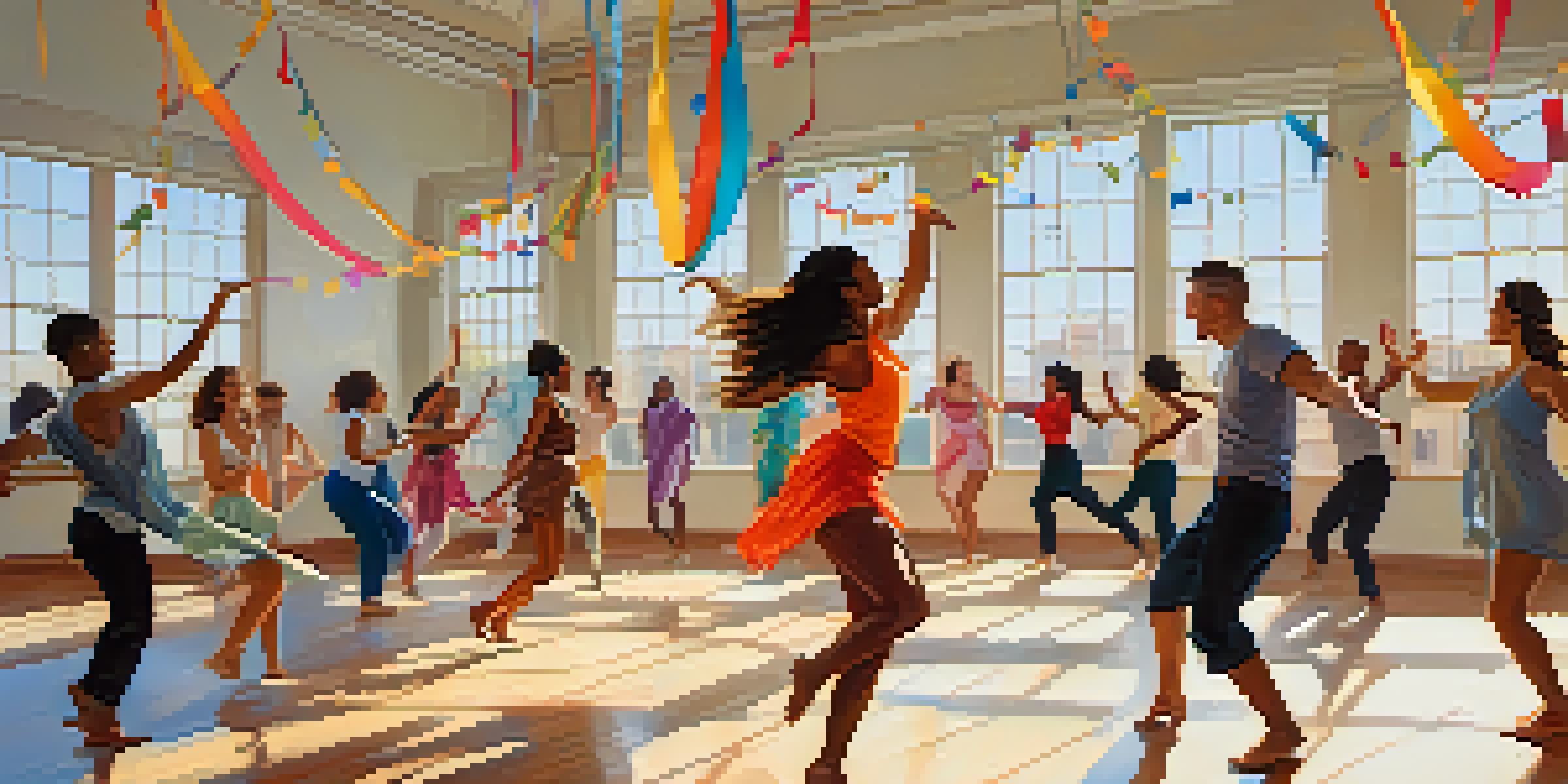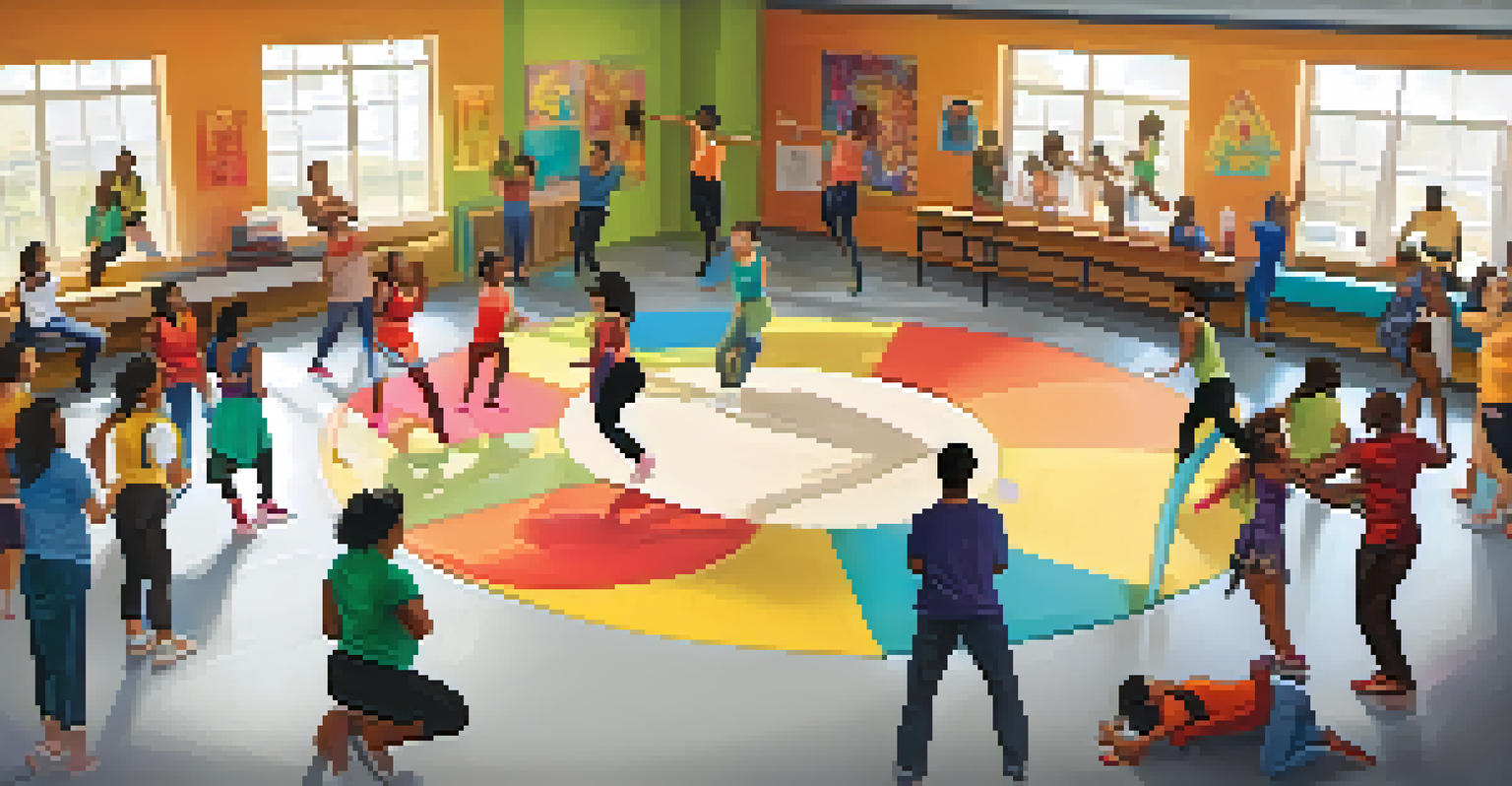How Dance Improves Team Dynamics and Collaboration Skills

Understanding the Connection Between Dance and Teamwork
Dance is often seen as an art form, but it can also serve as a powerful tool for improving teamwork. When team members engage in dance, they learn to communicate non-verbally, which is essential for effective collaboration. This connection between dance and teamwork highlights how rhythm and synchronization can translate into better group dynamics.
Dance is the hidden language of the soul.
Through dance, individuals are encouraged to listen to each other, creating a space where everyone feels valued. This listening is not just about hearing music; it involves tuning into the movements and intentions of fellow dancers. As participants learn to coordinate their movements, they simultaneously develop trust and understanding within the group.
Moreover, dance often requires improvisation, allowing participants to adapt and respond to their partners’ movements. This flexibility nurtures a collaborative spirit, encouraging team members to experiment and innovate together. Ultimately, the synergy found in dance mirrors the cooperation needed in a successful team environment.
Building Trust Through Collaborative Dance Activities
Engaging in dance activities can significantly boost trust among team members. When people dance together, they share a vulnerable experience, which naturally fosters connection. As team members rely on each other to maintain balance and rhythm, they build a foundation of mutual support.

This trust extends beyond the dance floor and seeps into daily workplace interactions. Teams that dance together often communicate more openly, leading to a culture of transparency. When individuals feel safe and supported, they are more likely to share ideas and feedback, which enhances overall collaboration.
Dance Builds Team Trust
Engaging in dance activities fosters mutual support and connection among team members, enhancing overall collaboration.
A great example is a team-building workshop that incorporates dance lessons. Participants might start off feeling hesitant, but as they move together, they quickly realize their shared goal. This camaraderie translates into stronger relationships that improve communication and collaboration long after the dance session ends.
Enhancing Communication Skills Through Movement
Dance offers a unique way to enhance communication skills, as it requires participants to express themselves without words. In this non-verbal context, body language and physical cues take center stage. Team members learn to interpret and respond to these signals, which sharpens their ability to communicate effectively in various situations.
Creativity takes courage.
For instance, a partner dance requires both members to be attuned to each other's movements. This awareness cultivates a heightened sense of observation, helping team members become more perceptive to their colleagues' needs and emotions. As they practice this skill in dance, they can transfer it back to everyday work scenarios.
Additionally, encouraging creativity through dance can lead to innovative problem-solving. When team members feel comfortable expressing themselves, they are more likely to think outside the box. This open atmosphere fosters collaboration, allowing diverse ideas to flourish and enhancing the team's overall effectiveness.
Promoting Inclusivity and Diverse Perspectives
Dance is inherently inclusive, drawing on a variety of styles and cultural backgrounds. When teams participate in dance activities, they can celebrate their differences while also finding common ground. This shared experience helps break down barriers and encourages diverse perspectives to be valued.
Incorporating different dance styles can also spark conversations about cultural heritage, fostering an appreciation for one another's backgrounds. When team members learn about each other's unique experiences, it enriches the team dynamic and promotes empathy. This understanding is vital for collaboration, as it allows individuals to approach problems from multiple angles.
Improves Non-Verbal Communication
Dance encourages participants to express themselves without words, sharpening their ability to interpret body language and cues.
For example, a team might explore African dance, hip-hop, or salsa during a workshop. Each style brings its own rhythm and energy, compelling participants to adapt their movements together. This collaborative dance experience not only builds skills but also cultivates a sense of belonging, making everyone feel seen and heard.
Encouraging Creativity and Innovation in Teams
Dancing together can serve as a catalyst for creativity and innovation within teams. When individuals are encouraged to explore movement freely, it often leads to new ways of thinking and problem-solving. This creative outlet allows team members to break away from traditional work patterns and express themselves in fresh, exciting ways.
Improvisational dance, in particular, invites spontaneity and risk-taking. As team members respond to each other's movements, they learn to embrace uncertainty and adapt quickly. This skill is invaluable in a workplace where change is constant, as it empowers teams to pivot and innovate in real-time.
Moreover, the joy and fun inherent in dancing can reinvigorate a team's spirit. When people enjoy what they’re doing, they’re more likely to engage wholeheartedly in their work. This positive energy not only enhances collaboration but can also lead to groundbreaking ideas that propel the team forward.
Fostering Resilience and Adaptability Through Dance
Dance is a dynamic art form that requires resilience and adaptability, two crucial qualities for effective teamwork. As dancers face challenges—like learning a new routine or synchronizing movements—they develop a mindset that embraces obstacles as opportunities for growth. This resilience is essential for teams navigating the complexities of modern work.
When team members participate in dance, they often encounter moments of imperfection, which teaches them to bounce back from setbacks. This ability to recover quickly fosters a culture of perseverance within the team. As individuals learn to adapt and overcome challenges together, they strengthen their collective resolve.
Encourages Creativity and Innovation
Dancing together allows team members to explore movement freely, leading to fresh ideas and innovative problem-solving.
For instance, during a dance rehearsal, a team may struggle with a particular sequence. Instead of feeling defeated, they work through the difficulty collaboratively, sharing tips and encouragement. This experience not only enhances their dance skills but also builds a robust framework for tackling challenges in their professional lives.
Creating Lasting Bonds Through Shared Dance Experiences
The shared experience of dancing can create lasting bonds among team members, which is vital for a cohesive work environment. When people engage in activities that require collaboration and trust, they build connections that extend beyond the dance floor. These bonds often lead to improved morale and a sense of belonging within the team.
As team members navigate the ups and downs of learning dance together, they create memories that reinforce their relationships. Celebrating successes and overcoming challenges together fosters a spirit of camaraderie. This strong foundation is essential for effective collaboration in any workplace setting.

Ultimately, the friendships formed through shared dance experiences can enhance teamwork. When team members genuinely care about one another, they are more likely to support each other's ideas and initiatives. This supportive atmosphere encourages open communication and collaboration, leading to greater overall success.